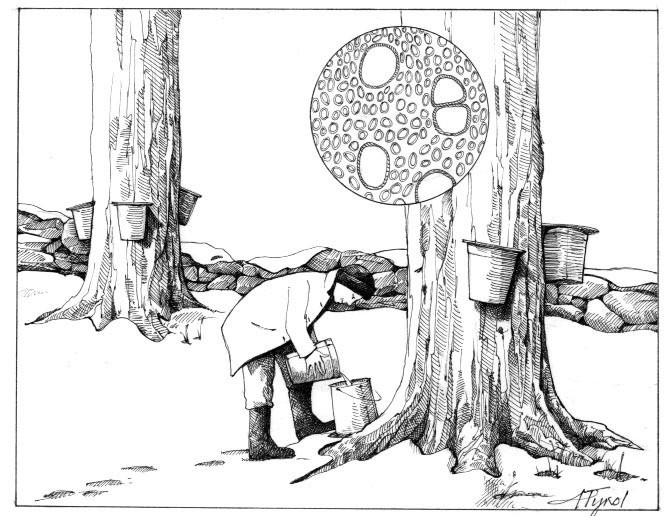
Like Town Meeting, which coincides roughly with the season’s start, making maple syrup is a perfectly democratic activity. It attracts farmers and loggers, quarrymen and surgeons, natives and urban transplants, whose levels of involvement can range from an operation with thousands of taps, miles of pipeline, and reverse osmosis equipment to one with a couple of buckets hanging from the yard maple out front and a kettle boiling sap on the barbecue grill.
But why does sap run?
Sugarmakers know that the optimal conditions require a night that’s below freezing followed by a day in which the temperature rises above freezing – preferably into the 40s. Logic would suggest that when you tap a tree you are intercepting the sap that is flowing from the roots to the branches as the day warms. That reasoning would be accurate if you were tapping a tree other than a maple. In a maple, however, the process is quite the opposite: when the sap runs after a thaw, it is running down the tree.
Dr. Melvin Tyree of the University of Vermont’s Proctor Maple Research Center described the process and the unique physiology of maples in a paper published in the Maple Syrup Journal. Hardwood sapwood is made up of vessels that move sap. Think of them as a bundle of straws. These vessels are surrounded by billions of living cells and dead wood fiber cells. In most trees, these fiber cells are water-filled; but in maples, they are filled with gas.
Because sap is essentially water, it expands when it freezes. Since the water-filled cells of most trees have no room for this expansion, most trees stop drawing in new sap during a freeze and expel whatever sap they already have in their branches out into the air. When maple trees freeze, however, they don’t release their sap out into the air. The gas-filled cells of the maple tree store this sap and even draw additional sap up from the roots through capillary action similar to that of a sponge. The sap then freezes as frost on the walls of the gas-filled cells. There it is stored until a thaw, at which point it runs.
The sap re-enters the sapwood vessels and, with an assist from gravity and the pressure of the gas bubbles that stored it overnight, flows back down the tree.
Incidentally, if a tree freezes quickly, the sap could freeze solidly rather than as a frost-like etching on the walls of the fiber cells. In that case there can be a surprisingly meager sap run when it thaws. The optimal situation is a slow gradual freeze that allows the cells to absorb the highest volume of sap, all of which will be released at the thaw.
Skeptical? Dr. Tyree suggests a small backyard experiment. During sugaring season, after a freezing night and while the tree is still frozen, cut down a sugar maple sapling close to the ground. As temperatures warm above freezing, you will notice that sap starts to weep out of the sapling’s trunk long before it resumes flowing out of the stump.
When you’re done, cut the sapling up into fuel length and save it to stoke the evaporator next season.


Discussion *